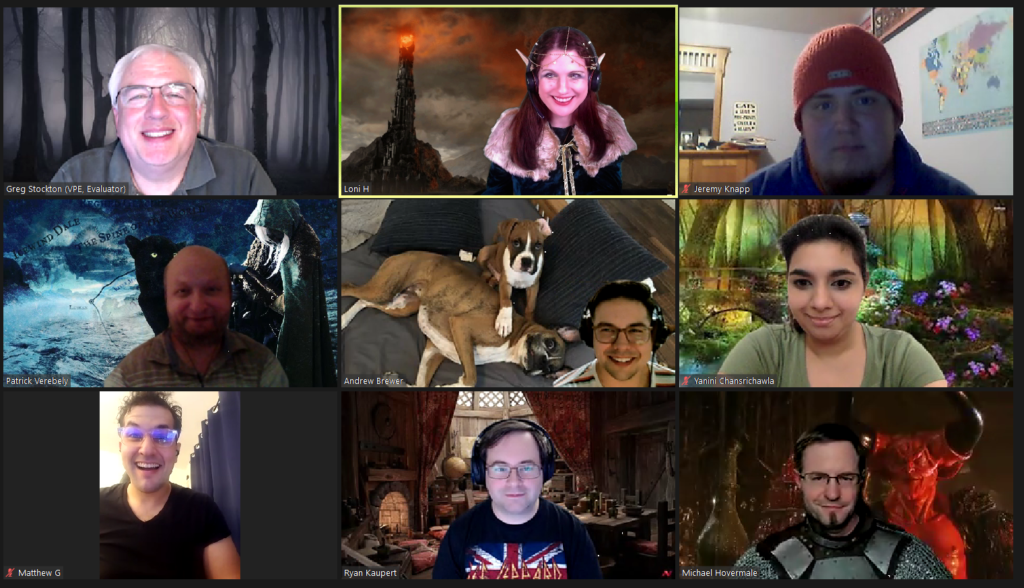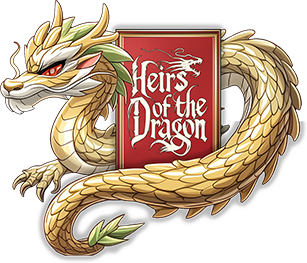Visit Dungeons & Toast
Learn More
Tales from the Round Table: Nightmare Triggers

Tales from the Round Table are the collaborative stories, instant character creations, wild speculations, and introspective responses that come from Dungeon and Toast's always-creative Table Topics.
For our Halloween-themed open house, Quest Master Greg. S. created a set of table topics from the stuff of nightmares…
Table Topics Master introduction: These Table Topics are designed to be nightmare triggers. Consider going with the story, reach for the horror, and let it play out in some way. They are designed to be specific in the setting but open as to the outcome.

- You receive a deed to a family home, for family members you’ve never heard of, in a place that doesn’t exist, but you know how to get there.
- You’re walking in the woods, there’s no one around and your phone is dead. Out of the corner of your eye, you spot it, following you.
- You’re home alone. For several days, things have seemed just a bit out of place. You head to bed, and on your pillow is a copy of “No Time to Die”
- You see a good friend on the street, and they have no idea who you are.
- You look in a mirror, and it’s ever so slightly out of sync with your movements.
- You come home, and somebody has been walking around with dirty shoes…on the walls and ceiling.
- You’ve had to spend much of your day dealing with your overly needy and energetic dog. As you finally get to sleep, you remember that the dog has been dead for two years.
- You get a phone call from a friend who died, and they speak as if nothing is going on.
- You have a penpal, through a service that delays all mail by 3 days. They begin sharing some problems they are having in their letters. Then one day write you a frantic letter about how they are in danger.
- You get a phone call that you can not hang up from. No matter what you do with your phone, which phone you pick up, or even if you just turn on the TV, it’s the same call…
- You open a book you’ve never seen before. Inside, the words, symbols, pictures are gibberish. When you’re in a dark room ready to sleep, you begin to remember and know things from it.
- You go to a show, to see an small group perform a show. It’s going along well, and then they point to you, and call you up…it’s your turn to perform.
- You come home and start to open the door. Your mother is there, and says “run” and slams the door.
- You go for a walk in the woods, and you begin to notice that trees die as you walk by.
- You are in a cave, and you’ve climbed down a deep hole. Finding nothing but a small area at the bottom, you climb back up. As you pull your rope up, it becomes taut.
Community Content Photos and Video Special Events
Winter Wonderland with Kelli the Opera Geek
This past Friday, we were honored to host Kelli Butler, the Opera Geek. She spoke about creating and roleplaying different characters as an exercise in exploring different aspects of one’s own personality. She also shared about her experiences — good and bad — playing in games streamed online for hundreds, sometimes thousands of viewers. We closed out our Open House with a Question & Answer session in which Kelli was gracious enough to share her thoughts on character alignment, best and worst in-game moments, and the importance of supporting Arts funding for education.
You can learn more about Kelli Butler at her web site, kellibutler.com or by following @theoperageek on Twitter. And for those who want to try out a new Bard College co-developed by Kelli Butler and game designer Hannah Rose, you can pick up a copy of the College of the Opera from DMsGuild. At just $1.99, this class archetype would make an excellent stocking stuffer!
Thanks to all members who assisted with planning and execution: Stephanie H., Greg S., and Loni H. And thanks to Cory and Stephanie H. for introducing Kelli to the club!
Advanced Club Officer Training with D100

This Saturday, Hovey, Patrick, Yanini, and I spent a couple of hours attending District 100’s amazing Advanced Club Officer Training. ACOT is available to any officer who has spent at least 1 year in the role for which they seek to be trained and is focused on a deeper dive into the specifics of each role with less time dedicated to the basics that need to be mastered first. Here are a few “lessons learned” from each member who attended, along with credit to their trainers:
Hovey – SAA Training – Bill Harmon, DTM
- Don’t Forget to GRIN:
- Greet – Send a private chat to each guest and welcome them in the chat; be sure to let them know they can privately chat you with any questions at any time.
- Recognize – Announce and welcome your guests at the top of the meeting.
- Invite – Invite the guest to join the club.
- kNow – Have a virtual Guest Book, or just have them chat you their email and/or phone so your VPM can follow up.
Patrick – President Training – Judie Bicknell, DTM
- Make sure you have a plan with concrete steps to take in order to achieve your club goals. The Club Success Plan can help with this.
- Add an open forum section to the board meeting agenda where officers can propose ideas. This ensures that their voice is heard and that they feel like part of the team and are contributing to the team. As the club president, speak last and/or only if no other club officers are speaking with respect to offering ideas for the club.
- Share the Distinguished Club Program Tracking form with club members at a club meeting so they can see where the club is at.
- If a club member attends a Club Executive Committee meeting and proposes an idea and it’s possible for the club to do it and if the club wants to do it, ask the club member if they want to be involved in the idea and/or Chair it.
- Ask club officers who may be without a club and/or club officer related project at the moment if they will help another club officer who is working on a club and/or club officer related project. Have club officers who are working on a club and/or club officer related project reach out to the club members at large to see if any of them can assist with the project. This also creates more engagement in the club among the club members at large.
Loni – VPPR Training – Alicia Curtis, DTM
- Instagram could be one potentially valuable outlet for PR, considering the highly visual nature of D&T club meetings and content.
- Meetup could be a second valuable outlet with many Meetup groups focused around roleplaying or improvisational speaking/acting; Meetup costs (approx. $60/month) are covered by District 100.
- We can submit upcoming events and details about successful events through the D100 web site.
- Having a custom URL (ex. dungeonsandtoast.com) and a custom web site (i.e., not freetoasthost) can make clubs seem more polished.
Yanini – Secretary Training – Iona Rodricks, DTM
- The Secretary prepares the agendas (weekly and executive committee) and distributes it.
- The Secretary should learn to prepare the agenda (does not have to be the Secretary all the time).
- Assign roles at least 4 weeks in advance to prepare members for their roles.
D&T Presents: A Yuletide Evening with Kelli the Opera Geek
Dungeons & Toast is pleased to welcome special guest Kelli Butler, AKA “Kelli the Opera Geek” at our meeting on Friday, December 10th. She will be speaking about the differences between in-house games and games streamed for a wider audience. There will be a Q&A session after she speaks.
Members and guests are also invited to don their weird apparel (hat tip Michael C.) for the first annual Ugly Holiday Sweater Contest.
We hope you will join us for this special event!
#D100
Vary Your Voice Venturesomely
GMs often struggle to differentiate their NPCs from one another. (We once joked that somehow all our GM’s NPCs seemed to have British accents.) In this video, voice actor Darren McStay demonstrates a number of vocal characteristics that can be layered to create distinct-sounding characters. A few of these characteristics include texture (breathy vs. dry), air placement (throat vs. nose), and tempo. Why not experiment with a few of these characteristics to add additional interest to your game world or player character?
2022 First-Term Election
“Leadership is not about titles, positions or flowcharts. It is about one life influencing another.”
John Maxwell
Now our newly elected Club Officers have titles, positions and goals to achieve. However, this is not their guiding purpose or their overall mission. Our Club Officers are united in their love of roleplaying, storytelling and many other hobbies that fall under the umbrella of geekdom. Their passion is to share the love of their hobbies with one another through the vehicle that a Toastmasters’ club has to offer.

We have a great team at the helm to continue making this a reality into the new year.
Evolution in Game Mastery

If there’s one thing Toastmasters pride themselves on (psst – there is more than one), it’s change or — more specifically — growth. It’s this growth mindset that brings us together every week to work on our craft, whether in a speaking, leadership, or evaluation role. In Dungeons & Toast, this outlook translates into players and game masters who constantly strive to better themselves, both through practice and introspection. Our Quest Master Greg S. recently penned an article about his own evolution as a Game Master, the way his perspective and execution has changed over the years. You can give it a read below.
Evolution of my GMing Style over the YearsFunny and Inspiring Halloween Costumes
The creator of the video below, Josh Sundquist, is missing one leg. Rather that let that limit him, he uses it as the basis of some amazingly funny costumes. Toastmasters helps us learn to go outside our own comfort zones, and play to our strengths; this short video seemed to fit both of those really well, while being both creative and hilarious.



























